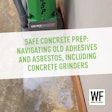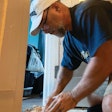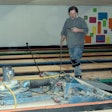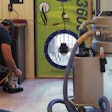

Working on floors is a strenuous job. The constant bending, crouching and lifting during a day on the job site strains and fatigues the muscles in the back and lower body. A single day of nailing or edging can leave you feeling exhausted, but these repetitive motions performed over a lifetime of contracting can lead to serious injury and even leave you unable to work.
The repetitive lifting in a forward-bent position required during a typical day on the job puts flooring professionals in a high-risk category for chronic lower back pain. Add vibrating equipment, such as a sander or a buffer, and then add smoking, and the risk increases further.
Lower back pain isn't just a nuisance; it's a serious problem that could cost you and your business a significant amount of money over the years. If you or your employees are unable to work because of injury, not only are you facing a possible labor shortage, you will pay higher medical claims. Lower back-related injuries are the second-leading cause of work absenteeism and the second leading reason for doctor visits. And, in the long-term, lower back pain is the leading cause of disability for workers under the age of 45.
Contractors constantly bend and lift but often do nothing to counteract this repetitive motion. By taking an easy proactive approach, you and your employees not only can stay in better shape, but can reduce the lost time and money associated with back problems. These simple exercises help ease the effects of flexion (bending forward with your back) and can be performed on the job site in just a few minutes. Encourage your employees to take several stretch breaks during the day—a few minutes of stretching could prevent several days lost from injury. Cardiovascular exercises such as walking or running also strengthen the spine and leg muscles and help reduce lower back pain. It's important with any exercise or stretch not to force it to the point of pain. (Consult a doctor if you have chronic back pain, other injuries, or medical concerns, and always consult a doctor before starting any exercise program.)
See the following pages for exercises to keep your back in business.
Leg stretches
Stretching the legs can help alleviate pressure on the lower back. Because the upper leg muscles are attached to the pelvis, they influence the position of the lower spine when bending backward and forward. Stay relaxed, don't bounce and don't force the leg to stretch beyond what is comfortable for you. If you are in pain, ease up. Do two or three repetitions for each leg, holding the stretch for 15 to 30 seconds.
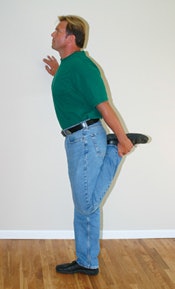
Quadriceps/Hip Flexor Stretch
This stretch works the front and side of the thigh. Be sure to stand straight, keep your thighs parallel and don't lean forward or backward.
Step 1: Stand next to a wall.
Step 2: Using the wall to support yourself, bend your leg until you can hold either your ankle or the cuff of your pants.
Step 3: Keeping your muscles relaxed and your movements slow, gently bring the heelof your foot toward your backside.
Step 4: Hold the stretch for 15 to 30 seconds.
Step 5: Repeat the stretch with the opposite leg.
Step 6: Perform the stretch one or two more times on each side.
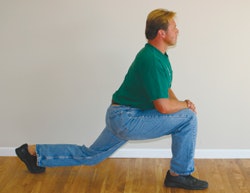
Hip Flexor Lunge
When performed correctly, you should feel this stretch in the front of the thigh and hip, not your knee. Perform this stretch with relaxed, gentle motions, keeping your hips parallel and pointing your leading foot straight ahead. If you feel shooting pain, consult your doctor or physical therapist.
Step 1: Keep your left foot in place as you take along step forward with your right leg.
Step 2: Bend your right leg to an approximately 90degree angle (do not let your left knee touch the ground).
Step 3: Lean your body weight forward onto your right leg.
Step 4: Hold the stretch for 15 to 30 seconds.
Step 5: Repeat the stretch with your left leg.
Step 6: Perform the stretch one or two more times on each side.
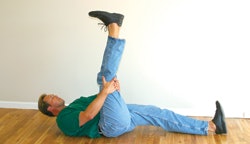
Hamstring Stretch
This stretch targets the back of your thigh. Keep your muscles relaxed and your back as flat to the ground as you can. Your head should be resting on the floor or as close to the floor as possible.
Step 1: Lie flat on your back.
Step 2: Hold one leg just behind the knee, making sure the opposite leg remains as flat to the floor as possible.
Step 3: Relaxing all of your muscles, including those in your neck,bring the leg you're holding straight up, being careful not to force the stretch.
Step 4: Hold the stretch for 15 to 30 seconds.
Step 5: Repeat the stretch with the opposite leg.
Step 6: Perform the stretch one or two more times on each side.
Back Stretches
These exercises help maintain an acceptable range of motion in your lower back and help counteract the repeated motion of flexion. All of these stretches are performed on your stomach while lying on the floor. Keep muscles as relaxed as possible and don't force the stretch. If you feel any shooting pain while in this position, stop the exercise and see a physical therapist immediately. Do these stretches up to two or three times per day for 2 to 3 minutes at a time.


Prone Stretch
Step 1: Lie flat on the floor on your stomach.
Step 2: Turn your face to the side and rest your head on the floor.
Step 3: Extend your arms out above your head. (If it's uncomfortable to extend your arms out above your head, keep your arms at your sides as shown in the inset photo.)
Step 4: Lie in this stretched position for 2 to 3 minutes.
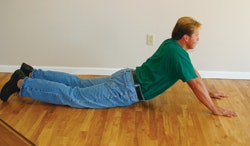
Prone-on-Elbows Stretch
Step 1: Lie flat on the floor on your stomach.
Step 2: Keeping your hips in contact with the floor, gently prop yourself up on your elbows.
Step 3: Take a deep breath. As you exhale, let your back relax and sag toward the floor.
Step 4: Hold this stretch for 2 to 3 minutes. If you are unable to hold the stretch for that long, lower yourself back down to the floor, relax for a few seconds and repeat for 2 to 3 minutes.
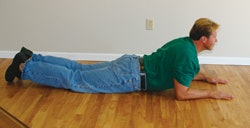
Prone Press-Up
Step 1: Lie flat on the floor on your stomach.
Step 2: Keeping your hips in contact with the floor, place your hands on the floor under your chest and gently rise as if you were doing a push-up.
Step 3: Exhale and let your back relax and sag toward the floor.
Step 4: If this stretch is uncomfortable, either extend your arms farther away from your body or bring them in closer to your body until you reach a comfortable position.
Step 5: Hold this stretch for 2 to 3 minutes. If you are unable to hold the stretch for that long, lower yourself back down to the floor, relax for a few seconds and repeat for 2 to 3 minutes.
Strengthening Exercises
These are the muscles that help hold your back upright. As with the previous exercises, stay relaxed and don't force yourself into an uncomfortable position. These exercises also can be done one limb at a time if the following variations are uncomfortable for you.


Prone Strengthening Variation 1
Step 1: Lie flat on the floor on your stomach.
Step 2: Extend your arms out over your head.
Step 3: Simultaneously raise your right arm and your left leg a few inches off the floor.
Step 4: Hold for a few seconds, then lower your arm and leg back to floor.
Step 5: Repeat this exercise using your left arm and your right leg.
Step 6: Repeat the exercise 8 to 12 times on each side.
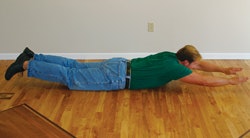
Prone Strengthening Variation 2
Step 1: Lie flat on the floor on your stomach.
Step 2: Extend your arms out over your head.
Step 3: Simultaneously raise both arms and both legs a few inches off the floor.
Step 4: Hold for a few seconds and lower both your arms and legs back to the floor.
Step 5: Repeat the exercise 8 to 12 times.
Lifting
Contractors who constantly are lifting heavy loads, such as the "big machine" or bundles of flooring, are more likely to develop lower back pain. Simply bending forward cause s a 50 percent increase in pressure on the discs in your back, and incorrect lifting raises that number to a whopping 185 percent.
Though it may seem basic, proper lifting technique is something that needs to be practiced just as much as any exercise or stretch. A typical person bends with the back more than 100 times per day, which makes poor lifting technique a hard habit to break. Lifting correctly requires strong muscles and joints, so it's important to practice this technique every day.
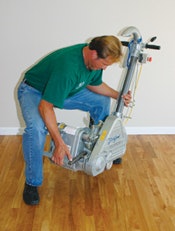
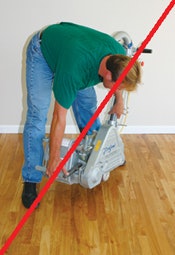
Proper Lifting Technique
Step 1: Get as close to the object to be lifted as you comfortably can.
Step 2: Keeping your back muscles as relaxed as possible, bend your knees, plant your feet in a wide stance and lift up using your leg muscles.
Improper lifting technique
Don't bend forward with your back.
















